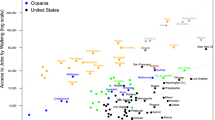Abstract
Tel Aviv is the largest metropolitan area in Israel and serves as the country’s main financial and cultural centre. The Tel Aviv Metropolitan Areal stretches over 1,475 square kilometres and is inhabited by 2.6 million people, of which 90 percent are living in urban areas. Data from 1999 show that the Tel Aviv Metropolitan Area produced 50 percent of the GDP and was responsible for 46.4 percent of the jobs in Israel. Because of its geographical position and for historical reasons, the Tel Aviv Metropolitan Area is a transportation focal point. All traffic between the north and the south of Israel, as well as traffic connecting the main cities (Jerusalem, Tel Aviv, Haifa and Beer Sheba) to each other, must pass through the Tel Aviv Metropolitan Area. Thus, the metropolitan transportation infrastructure must fulfil two major functions: a) supply the demand for transportation on the national level; and b) supply the demand for transportation within the metropolitan area on the regional and local levels.
Access this chapter
Tax calculation will be finalised at checkout
Purchases are for personal use only
Preview
Unable to display preview. Download preview PDF.
Similar content being viewed by others
References
Cervero R. 1998: The Transit Metropolis — A Global Inquiry, Island Press, Washington DC
Dreborg K.H. 1996: Essence of Backcasting, Futures, Vol. 28, 9 , 813–828
Ginsberg G., Serri A., Elaine F., Shemer J., Koutik D. and Karsenty E. 1998: Mortality from Vehicular Particulate Emissions in Tel-Aviv Jafo, World Transport Policy & Practice
Haq G. 1997: Towards Sustainable Transport Planning, Ashgate, Aldershot England (reprint 1999)
Kahn H. and Wiener A.J. 1967: The Year 2000: A Framework for Speculation on the Next Thirty-Three Years, New York, Macmillan Co.
Linstone H.A. and Turrof M. 1975: The Delphi Method — Techniques and Applications, Addison-Wesley Publishing Company, Inc.
Masser I., Sviden O. and Wegener M. 1992: From Growth to Equity and Sustainability — Paradigm Shift in Transport Planning, Futures, Vol 24, July-August
Masser I., Sviden O. and Wegener M. 1993: Transport Planning for Equity and Sustainability, Transportation Planning and Technology, Vol. 17, 319–330
Nijkamp P. 1999: Sustainable Transport: New Research and Policy Challenge for the Next Millennium, European Review, Vol. 7, 4, 551–677
Nijkamp P., Rienstra S. and Vleugel J. 1998: Transportation Planning and the Future, John Wiley & Sons Ltd, Chichester, England
Newman P. and Kenworthy J. 1999: Sustainabilty and Cities — Overcoming Automobile Dependence, Island Press, Washington, DC
Pearman A.D. 1988: Scenario Construction for Transport Planning, Transportation Planning and Technology, Vol. 12, 1
Reibnitz U.V. 1987: Scenario Techniques, McGraw-Hill Book Company Gmbh, Hamburg
Ringland G. 1998: Scenario Planning — Managing for the Future, John Wiley & Sons, Chichester
Sheskin D.J. 1997: Handbook of Parametric and Nonparametric Statistical Procedures, CRC Press, 83–94, 291–302
Statistical data from the official website of the Israeli Police Department, 2000. Internet website: www.police.gov.il
Stead D. and Banister D. 1999: Transport Policy Scenario Building: Findings from the POSSUM Project, Paper presented at the NECTAR Conference, Delft, October
Author information
Authors and Affiliations
Editor information
Editors and Affiliations
Rights and permissions
Copyright information
© 2004 Springer-Verlag Berlin Heidelberg
About this chapter
Cite this chapter
Shiftan, Y., Kaplan, S., Hakkert, S. (2004). Scenario Building for the Future of the Tel Aviv Metropolitan Area and Its Transportation System Using the Delphi Method. In: Beuthe, M., Himanen, V., Reggiani, A., Zamparini, L. (eds) Transport Developments and Innovations in an Evolving World. Advances in Spatial Science. Springer, Berlin, Heidelberg. https://doi.org/10.1007/978-3-540-24827-9_14
Download citation
DOI: https://doi.org/10.1007/978-3-540-24827-9_14
Publisher Name: Springer, Berlin, Heidelberg
Print ISBN: 978-3-642-05673-4
Online ISBN: 978-3-540-24827-9
eBook Packages: Springer Book Archive




